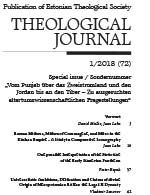Depositio barbae Das kaiserzeitliche Bartfest als Initiationsritus
Depositio barbae Das kaiserzeitliche Bartfest als
Initiationsritus
Author(s): Christopher DegelmannSubject(s): Cultural history, Ancient World
Published by: Akadeemiline Teoloogia Selts
Keywords: Nero; Tacitus; Suetonius;
Summary/Abstract: Both Tacitus and Suetonius report concordantly that during his ostentatious initiation into adulthood the young emperor Nero performed a strange ritual: At the age of 21 (59 AD), he shaved off his beard entirely, put the hairs into a little case and afterwards brought them up to the Capitol in order to dedicate them to the divine trinity of Jupiter, Juno and Minerva. Between 13 and 18, boys, just like senators, used to wear the toga praetexta. After this period though, all adolescents put down their praetexta and exchanged it for a white toga. This toga pura or libera signified the freeborn, male Roman and revealed the legal, sexual and socio-cultural status the young man had attained. This first ritual admission into the realm of adulthood gained increasing attention within classical scholarship which became more sensitive to issues concerning the history of the body and gender and thus particularly interested in the strategies of distinction, staging and conservation of status during the acceptation of the toga for men (togam virilem sumere). However, the so-called barbatoria, which Nero performed on himself at a considerably advanced age (as indicated above), has only been treated rather incidentally in scholarship so far. Nevertheless, the growing, shaving and maintaining of a beard provided at the time important information about the intersectional identity of a person which had to be either preserved or negated under the influence of rumour. This contribution will compile the few known “realia” concerning the Roman beard-festival of the early imperial period which will then contribute to an typical reconstruction of the ritual. The main focus lies on the ritual’s religious implications. On this basis, the contribution will shed light on the function and importance of the barbatoria in the life cycle of young Romans as well as on the political dimension of its instrumentaliation. It will be shown that this second phase of the initiation process which took place after the toga-celebration served to create a religiously and ritually mature citizen by having him perform a sacrifice whereas the former act of togam virilem sumere simply symbolised his passage into public life.
Journal: Usuteaduslik Ajakiri
- Issue Year: 2018
- Issue No: 1 (72)
- Page Range: 93-122
- Page Count: 30
- Language: German

